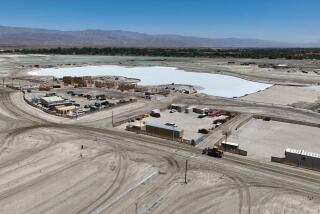Editorial: Is Newhall Ranch a new model of sustainable sprawl? Absolutely not
The massive Newhall Ranch project in northern Los Angeles County may be one of the most environmentally friendly suburban developments ever planned in California.
After extensive negotiations with environmental groups, the developer of the 21,500-home project committed to set aside 1,250 acres, or roughly 10% of the development, for reintroduction of the rare San Fernando Valley spineflower. It agreed to provide $25 million for conservation efforts. The project also will include 10,000 solar installations — and electric vehicle charging stations in every home, plus more in the surrounding community. It will offer electric school buses and bike shares.
In addition, greenhouse gas emissions from the project will clock in at “net zero.” That is, the developer committed to offset all the global warming emissions created during the construction and operation of the development by funding projects that, for example, cut methane from dairy farms in California and reduce pollution from cooking stoves in sub-Saharan Africa.
If California is serious about slowing climate change, then the state cannot continue to sprawl outwards. Cities have to grow inward.
But even though Newhall Ranch will be better than most suburban-style developments that have been built in California over the last 50 or 75 years, that doesn’t make it good.
It is still sprawl. It will convert open space into pavement, which will not absorb stormwater and therefore will worsen river and ocean pollution. It will replace cooler terrain with heat-absorbing asphalt and buildings, which will make developed areas hotter. It will put tens of thousands of new residents far from job centers and mass transit, leading to more driving, more traffic and more pollution.
If California is serious about slowing climate change, reducing air pollution, using its water wisely and protecting wildlife, then the state cannot continue to sprawl outwards. Cities have to grow inward — with more infill development, more density and more housing closer to jobs and transit.
Redesigning communities to accommodate more residents makes better use of existing roads and infrastructure. Greater density makes it easier for people to walk, bike or take transit. Why is this necessary? Because if California is going to meet its goals of reducing greenhouse gases to slow climate change, the state will have to dramatically reduce emissions from the transportation sector.
Admittedly, the need to curtail sprawl conflicts with another priority in California — the need for more housing and especially for affordable housing. That was a big reason why the Los Angeles County Board of Supervisors gave the go-ahead for the Newhall Ranch project in July, including approval to build the first two of five planned subdivisions.
Most of the housing built in the state over the last six decades has been in subdivisions made up of single-family homes and low-slung apartments on the periphery of towns, where land is cheaper and there’s less opposition to new construction.
But the march of the suburbs farther and farther from California’s urban centers has had serious environmental and social repercussions. It has allowed existing communities to reject new housing in their immediate backyards. Workers in search of affordable homes often move far from their jobs, enduring long commutes in ever-worsening traffic. And suburban-style developments tend to consume more water (for irrigating lawns) and generate more emissions (because they’re designed for cars) than more compact urban developments.
While a “net zero” green development like Newhall Ranch is certainly better than most suburban developments, it nevertheless paves the way (so to speak) for more sprawl. Once the infrastructure is built for one new development on the urban fringe, it makes it more likely that another will follow.
It’s not enough to reject sprawl. Californians have to embrace more housing construction within existing communities.
Follow the Opinion section on Twitter @latimesopinion and Facebook
More to Read
A cure for the common opinion
Get thought-provoking perspectives with our weekly newsletter.
You may occasionally receive promotional content from the Los Angeles Times.










